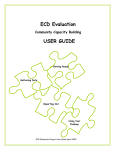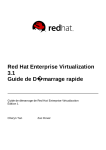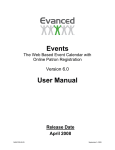Download USER'S GUIDE - Success By 6
Transcript
ECD Evaluation Community Capacity Building USER GUIDE Getting Ready Gathering Data Reporting Out Using Your Findings ECD Evaluation Project User Guide Revised January 2011 Table of Contents 1 About the Guide ................................................................................................................................3 2 The Purpose of this Project.................................................................................................................3 3 4 2.1 Background.......................................................................................................................................................... 4 2.2 How the Evaluation Results will be Used ............................................................................................................ 4 2.3 Timeframe ........................................................................................................................................................... 4 About Evaluation in General ...............................................................................................................5 3.1 What is Evaluation? ............................................................................................................................................. 5 3.2 Why Evaluate? ..................................................................................................................................................... 5 3.3 Evaluation Terms ................................................................................................................................................. 5 3.4 The Program Logic Model ................................................................................................................................... 6 Capacity Building Evaluation Overview ...............................................................................................7 4.1 What and How We Will Measure ........................................................................................................................ 7 4.2 When To Measure ............................................................................................................................................... 7 4.3 What To Do with the Data? ................................................................................................................................. 7 4.4 Interpreting the Results of the Data Gathering ................................................................................................... 8 4.5 Reporting your Evaluation Outcomes ................................................................................................................. 8 5 Completing the Coordinator/Managers Output Reporting Survey .......................................................8 6 Completing the ECD Stakeholders Outcome Reporting Survey .............................................................9 Tips for Getting Good Response Rates ............................................................................................................. 10 7 APPENDIXES ....................................................................................................................................12 7.1 APPENDIX A – Logic Model ....................................................................................................................................... 12 7.2 APPENDIX B – ECD Managers Survey ........................................................................................................................ 14 7.3 APPENDIX C – Stakeholders Survey ........................................................................................................................ 26 7.4 APPENDIX D – Interpreting Data; The Community Action Report ........................................................................... 32 7.5 APPENDIX E - One Page Project Information Handout ………………………………………………………………………………………….35 7.6 APPENDIX F – Quick Guide to the Community Building Evaluation ......................................................................... 36 7.7 APPENDIX G – Glossary ............................................................................................................................................. 37 Print Me!! (I’m the Guide in a nutshell) ECD Evaluation User Guide 2 1 About the Guide This guide is intended for the use of ECD Coordinators/Managers participating in the ECD Evaluation Project. The project is a collaborative effort of representatives from Success By 6®, Children First, the Community Action Program for Children [CAPC], United Way of the Lower Mainland, BC Ministry of Children and Family Development (MCFD), Public Health Agency of Canada (PHAC), Human Early Learning Partnership (HELP) and local BC communities. The partners thank the Max Bell Foundation for their generous financial support of this project. 2 The Purpose of this Project 2.1 Background In the spring of 2006, a group of funders of early childhood development initiatives in BC (the BC ECD Funders Table) agreed upon a vision and four shared long-term goals for early childhood programs and services: Vision: Children are healthy and develop to their full potential Long Term Goals 1. Mothers are healthy and give birth to healthy infants who remain healthy. 2. Children experience healthy early child development, including optimal early learning and care. 3. Parents are empowered and supported to nurture and care for their children1. 4. Communities support the development of all children and families. Subsequently, three initiatives - CAPC (Community Action Program for Children), Children First and Success By 6® agreed to work together to design an integrated evaluation system related to goal #4 (Phase 1). Their objectives were to reduce the reporting burden on ECD capacity building initiatives that were having to report in different formats to different funders; and develop a reporting system that had the capability of demonstrating province-wide outcomes. Phase 1 involved designing and pilot testing the evaluation system. A number of communities were invited to take part in a pilot. The communities were chosen with a view to reflecting the diversity of the population around the province: geographic, urban, rural, Aboriginal and culturally diverse populations. Sixteen communities agreed to participate. An evaluation framework (logic model) and two data collection tools (questionnaires) were developed with input from the partners. The first of these questionnaires, The Managers Survey, was designed to gather “output” information from managers of the ECD initiatives. The second questionnaire, The Stakeholders 1 The original wording was slightly different. ECD Evaluation User Guide 3 Survey, was designed to gather “outcomes” information from local ECD table participants and other stakeholders. The pilot communities collected data spring, 2007. A central data processing resource collated the data and reports were sent back to the pilot communities. Subsequently, local initiatives met to discuss the evaluation findings and write brief final reports. Lessons learned in the pilot were used to refine the evaluation system and it was administered in 60 communities in 2008 and in 75 communities throughout BC in 2009. Refinements have been made to the survey instruments after each administration. Each roll out of the evaluation demonstrated the amazing work being done around the province by ECD Tables! This revised version of the Guide is intended to assist coordinators to participate in the provincial evaluation in 2011. The Success By 6 office will provide the central data processing functions for all participating ECD initiatives. 2.2 How the Evaluation Results will be Used It is expected that evaluation results will be useful to the local communities to assess the progress of their ECD initiatives, make improvements where indicated and as a reporting mechanism to funders. The results from all the evaluations will be rolled up to provide province wide and regional overviews of ECD capacity building work. 2.3 Timeframe Here is the timeframe for the 2011 evaluation: January 13 – 17, 2011 – several conference call training sessions will be held. Choose the one that best suits you. January 17 - 28 – ECD Managers and Stakeholders throughout BC will complete their surveys online. February – Data will be downloaded from online surveys and reports will be compiled by the Success By 6 office. Late February – Reports will be sent to communities by the Success By 6 office. Subsequently– Data interpretation workshops are held in local communities, discussing successes, challenges and plans for any action that will be taken as a result of the evaluation. Evaluation reports are submitted to funders. ECD Evaluation User Guide 4 3 About Evaluation in General 3.1 What is Evaluation? A straightforward dictionary definition of evaluation is “to put a value on something”. Fundamentally, evaluation asks the following questions: 1. 2. 3. 4. 5. What? - Did we do what we said we would do? Why? - What did we learn about what worked and what didn't work? So what? - What difference did it make that we did this work? Now what? What could we do differently? Then what? How do we plan to use evaluation findings for continuous learning? 3.2 Why Evaluate? Evaluation has two main purposes: for learning and development and for accountability - i.e. to show others that your program is effective. For learning and development: Evaluating your program will help you assess how well you are doing in order to help you do it better. It is about asking what has happened and why - what is and what is not working. It is about learning more about your activities, and then using what you have learned for improvement. For accountability - to show others that you are effective Funders and other 'stakeholders' want to know that projects are effective. Evaluation allows you to provide evidence of your success and strengthen the case for continuing your program. Evaluation should not only answer questions. It should also prompt fresh thinking within your initiative and with your contacts from external agencies. If you have asked the right questions, an evaluation will tell you not only what you have achieved, but also how you did it and what was most effective. For a good evaluation, data must be collected and analyzed systematically and interpreted carefully. 3.3 Evaluation Terms Commonly used evaluation terms include: goals, objectives, benchmarks, outcomes, outcome indicators, outputs, inputs and activities. You will find definitions of these terms in the Glossary (Appendix G) of this guide. ECD Evaluation User Guide 5 3.4 The Program Logic Model A logic model is a diagrammatic representation of a program, showing what it is supposed to do, with whom, and why. Logic models show the link between what we do and the impact we are having; provide a common vocabulary; focus on quality and continuous improvement. Logic models bring detail to broad goals and show the chain of events that link inputs to results – i.e. the relationship between what we put in (inputs), what we do (outputs) and results (outcomes): Program Logic Model - The Outcomes Chain The resources expended to achieve our goals Inputs What our program does with the Inputs Activities The direct products of the activities (usually measured in volume) Outputs The initial benefits of a program - often a change in knowledge, attitude or skill Short Term Outcomes How we know if we have affected change Intermediate Outcomes Links the short term outcomes to the long term outcomes - often a change in behaviour resulting from a change in knowledge attitude or skill Long Term Outcomes Indicators The ultimate change expected often a change in condition or status (The logic model for this evaluation is Appendix A to this Guide.) ECD Evaluation User Guide 6 4 Community Capacity Building Evaluation Overview 4.1 What and How We Will Measure: For the purpose of this evaluation, we measure Outputs (the direct products of your activities) and the short/intermediate term Outcomes (results). The questions we will be asking related to the Outputs and Outcomes have been drawn from the list of Indicators in the logic model (see Appendix A). Outputs: The Outputs are measured using the ECD Managers Survey which captures data on a number of Output Indicators. The Coordinator of each ECD initiative completes one of these forms in an online format, using the “Survey Monkey” tool. A link to the tool is provided to participating Coordinators/Managers by email. Outcomes: The short term/intermediate Outcomes are measured using the ECD Stakeholders Survey. Coordinators in each community invite participants/stakeholders involved with ECD initiatives to complete these surveys in an online format, again using the “Survey Monkey”. 4.2 What we do with the Data? When all initiatives have completed entering their data, our central data processing (the Success By 6 office) will compile the data, create a roll–up of province-wide information and provide you with individual and roll-up reports. This phase should be completed by the end of February. You can then review and interpret the results with your community tables, make decisions about how the evaluation results will be used, and report back to your funders. 4.3 Interpreting the Results of the Data Gathering Interpreting your data involves putting it into perspective – for example, comparing results to what you expected, or to initiative goals, or to the results of similar initiatives, then drawing conclusions. In this instance, you will be able to compare your results to your initiative goals where appropriate and to the results of the province-wide roll up. Data from this year may serve as a benchmark for future evaluations that ask similar questions. The data reports will quantify your data in some way – for example: “75% of respondents agreed that the community table is reflective of community diversity, while 25% of respondents disagreed” or “80% of respondents agreed that community awareness of the importance early childhood development has increased over the past 12 months, while 10% disagreed and 10% didn’t know. Numbers do not speak for themselves. They need to be interpreted based on careful and fair judgments. Similarly, narrative statements need interpretation. The same information can be interpreted in various ways. As Coordinator, you will have your own perspective. Others will look at your information through different eyes. Greater understanding usually ECD Evaluation User Guide 7 results when you take the time to hear how different people interpret the same information, so it will be important to involve your ECD table in the interpretation process. It is recommended that you hold a data interpretation workshop with your ECD table. We would like your table to review your successes, challenges and what you plan to do regarding the issues you have identified. This meeting would provide an opportunity for the group to engage, reflect upon and interpret data and to develop implications from the data about your initiative. An outline for such a workshop and the reporting template are attached to the Guide as Appendix D. 4.4 Reporting your Evaluation Outcomes At the end of the evaluation process, it is anticipated that you will provide your respective funders with copies of: 1. The Data Analysis Reports (provided to you by central data processing). These will include: your Manager’s Report (Outputs Report), a one-page Outcomes Chart and an Outcomes report based upon your Stakeholders surveys. 2. Other reports as requested by your funders. 5 Completing the Managers Surveys The Managers Survey allows you to document the direct products of your activities. It is anticipated that this information can be extracted from your meeting minutes, ECD plans, marketing plans, etc. Enter your data in the online Survey Monkey between January 17 – 28th. Appendix B to this guide is a copy of the online survey and will walk you through the questions. The brown “callouts” should clarify the questions where necessary. Use this form to gather the data you require prior to completing the online version. Be sure to have this Appendix in hand as you enter your data into the Survey Monkey! ECD Evaluation User Guide 8 6 Completing the Stakeholder Surveys The Stakeholders Survey should be completed by people who are involved in your initiative. You can solicit the participation of members of your steering committee, subcommittee members and others in the community who are involved in helping your ECD community table to reach its goals. Most ECD Tables invite those active in the work of the ECD Table rather than everyone on their mailing lists. (Those who are not active are not likely to be able to answer the questions, nor are they likely to complete the form.) You will be provided with a link to the survey and an ECD Community Table Code. (The Code allows us to filter results by initiative). You can simply email the link and code to prospective respondents, along with some explanation of what you want them to do. For example: “Dear Mary (or “Colleagues” etc., if you are sending a group email), As you know, Success By 6® and Children First ECD tables in communities around the province, including our own, are participating in the 2011 ECD Community Capacity Building evaluation. As a local partner in our ECD community table’s work, please take the time participate in the evaluation by completing an online Stakeholder Survey by January 28. To access the Stakeholder Survey, simply click on this link (survey link). At the beginning of the survey, you will be asked to enter a code for our ECD community table and to identify our ECD table’s MCFD Region. Our ECD Community Table Code is: (3 letter code) and our MCFD Region is (MCFD Region) and our Success By 6 region is (Success By 6 region) [if applicable]. Please note that you will not be able to proceed through the survey until you enter the code and MCFD region. The survey should only take 15 – 20 minutes. You will need to complete the survey at one sitting since you will not be able to get back in when you exit the survey. Your responses are confidential and your name is not requested in the survey. Your participation is very important! The data from our community will assist us with local planning and province-wide data will be used to create an overview of the powerful community building work that is taking place around the province. If you have any questions about the survey, please contact me. [your name], ECD Coordinator” ECD Evaluation User Guide 9 PS: I would appreciate if you would send me a quick note when you have completed your survey, so that I can cross you off my list! Individual respondents to the Stakeholders Survey will be asked which sector they belong to (e.g. “Health”; “MCFD”; “Community Non Profit Agency”), but will not be identifiable by name. Copies of both the online Stakeholder surveys are attached to this Guide. Tips for Getting Good Response Rates: 1. Let prospective participants know about the survey ahead of time – if possible in-person, at a meeting of your initiative. Distribute the one-page project information sheet which provides background information in the project [Appendix E]. Tell them that their participation is valuable, that it will be appreciated and that it will help to move the work of your initiative to a new level. Provide them with your timelines and ask for their commitment. 2. If possible, send out individual emails with the survey link to potential respondents, rather than a group message. 3. Ask people to email you back when they have completed the survey. Then you can cross them off your list and send reminders to those who have not completed the survey. 4. Give a maximum of two weeks for responses. Typically, people will respond in the first few days. Then, two or three days before your deadline, send out a reminder to your stakeholders letting them know that the deadline is approaching, thanking those who have responded and encouraging anyone who has not responded to do so by your deadline. For example: Dear Colleagues (or whatever form of address you usually use), The deadline for responses to the Stakeholder survey is (date). Thanks to those of you who have responded. If you have not yet completed a survey, please try to do so by the deadline. Your participation is important! Here again is the link to the survey (survey link). Our ECD Community Table Code is: (3 letter code) and our MCFD Region is (MCFD Region) and our Success By 6 region is (Success By 6 region) [if applicable]. Thank you for your participation. [your name], ECD Coordinator. P.S Please remember that you must complete the online survey at one sitting - once you have exited the survey link, you will not be able to re-enter." 5. Offer incentives or prize draws for all those who have completed the survey early or by the requested date. Prizes can be anything, such as a gift certificate, a book or anything else you can muster up. 6. A day or two after your deadline, you may contact the Survey Administrator, Cheryn Wong ([email protected] )to determine how many people have responded to your survey (we ECD Evaluation User Guide 10 won’t be able to tell you “who” has responded though – just the number of responses). If you feel that you need more responses, you can send out a final email. For example: Dear Colleagues (or whatever form of address you usually use), The deadline for responses to the Stakeholder survey is now past. Thanks to those of you who have responded. The Survey Administrator tells me that the response from participants in our initiative is a bit low, so I am extending the deadline for another three days - until the end of the day on (Date) in hopes that those of you who have not responded will do so. It only takes a few minutes. Please take this last chance to provide your input! Here again is the link to the survey (survey link) Our ECD Community Table Code is: (3 letter code) and our MCFD Region is (MCFD Region) and our Success By 6 region is (Success By 6 region) [if applicable]. Thanks again. [your name], ECD Coordinator ECD Evaluation User Guide 11 7.1 APPENDIX A - ALIGNED EARLY CHILDHOOD DEVELOPMENT (ECD) LOGIC MODEL BUILDING COMMUNITY CAPACITY (Revised - March 2009) OUTPUTS OUTPUT INDICATORS OUTCOMES Shorter term 1. Active cross sectoral table 2. Use of research and evidence based information 3. Inclusive local ECD plans are in place 4. Local evaluation is initiated 1. Local awareness initiatives 2. Local resource development /allocation 3. Community Engagement 1. Service coordination 2. Accessibility initiatives 3. Training/mentorship opportunities 1a. # and type of community partners 1b. # of table/subcommittee meetings 1c. # of funded hours of coordination time 2a. # and type of ECD-related research used 3a.# of ECD plans that are developed 3b. # and type of partners participating in planning 3c. # and type of processes used to create plans 3d. # and type of strategies that are developed 3e. # and description of local priorities 4a. # and type of table-led evaluation initiatives 1a. # and type of awareness messages 1b. # of awareness activities 2a. # and type of local allocations decisionmaking processes 3a. # of volunteers; # of community leaders engaged 1a. # and type of coordination activities 1b. # and type of MOU’s in place 1c. # and type of new or improved programs 1d. # and type of changed or new policies 2a. # and type of accessibility activities 3a. # and type of training/mentorship activities Longer term More inclusive / active community coalition Improved knowledge and ability to use research and evidence to guide initiatives Improved Community Planning and Coordination Increased use of a local ECD plan to guide initiatives Increased use of evaluation for improvement Increased community awareness of the importance of the early years Increased community resource development & allocation Increased community engagement Increased service coordination and integration Increased accessibility Improved knowledge of best practices in ECD ECD Evaluation Project User Guide Revised January 2011 Improved Community Awareness & Mobilization Improved Service Delivery ULTIMATE OUTCOME Communities support the development of all children and families OUTCOMES OUTCOME INDICATORS Improved Community Planning and Coordination # and % of community table participants who agree that: 1. More inclusive / active ECD community table 2. Improved knowledge and ability to use research and evidence to guide initiatives 3. Increased use of local ECD plan to guide initiatives 1a. The table reflects the diversity of the community 1b. They are working well together to strengthen ECD 2a. Research has been used to guide the work of the initiative 3a. The ECD plan has guided the initiative 4a. Evaluation is being used to foster improvement 4. Increased use of evaluation for improvement # and % of community table participants who can provide examples related to the above indicators Improved Community Awareness and Mobilization 1. Increased community awareness of the importance of the early years 2. Increased local resource development and decision making 3. Increased community engagement Improved Service Delivery 1. Increased service coordination and integration # and % of community table participants who agree that 1a. Community awareness of the importance of ECD has increased 2a. The ECD table has increased its ability to make joint decisions related to ECD resources 3a. Increased volunteerism is helping to mobilize the community 3b. Increased participation of community leaders is helping to mobilize the community # and % of community table participants who can provide examples related to the above indicators # and % of community table participants who agree that 1a. Services are improved as a result of better coordination 2a. Services are more accessible to families and young children 3a. Staff and volunteer training/mentorship has led to improved service delivery 2. Increased accessibility 3.Improved knowledge of best practices in ECD # and % of community table participants who can provide examples related to the above indicators ECD Evaluation User Guide 13 This is the survey as it will appear on the Survey Monkey 7.2 APPENDIX B – ECD Managers Survey WELCOME TO THE ONLINE MANAGERS SURVEY: 2011 ECD COMMUNITY BUILDING EVALUATION Thank you for completing the ECD Manager's Survey Report. The data from your community and other communities in BC will assist us in creating a comprehensive overview of the powerful ECD community building work that is taking place around the province. It will also provide your ECD community planning table with information that will assist you in your ongoing planning for children and families. There are a total of 40 questions in this Report form. Many of these can be answered quickly. There is a copy of this form in the ECD Evaluation User Guide. It is suggested that you use the form in the Guide to assemble information, prior to completing this online version. There are some questions that require you to enter actual numbers (rather than check marks or X's). If you enter an X or a check mark where a number is required, the Survey Monkey will take you back to the place(s) where you made an error and ask you to enter a number before allowing you to advance to the next page. In addition, you must answer the questions marked with an asterisk in order to proceed. The survey allows ONLY ONE RESPONSE PER COMPUTER. You may return to your survey to update/change your responses, but you must do so on the SAME computer you used to start with. 1. Before proceeding, please enter the ECD Planning Table Code that was sent to you with the survey link here: You must answer the first 2 questions before proceeding. Your Code and Region will be in the email you will receive with the survey link 2. Which MCFD Region of the province is your ECD planning table in? North Fraser Interior Vancouver Coastal Vancouver Island 3. Which school district (or districts) are in the area in which your initiative works (check all that apply)? 5 Southeast Kootenay 43 Coquitlam 67 Okanagan - Skaha 6 Rocky Mountain 44 North Vancouver 68 Nanaimo - Ladysmith 8 Kootenay Lake 45 West Vancouver 69 Qualicum 10 Arrow Lakes 46 Sunshine Coast 70 Alberni 19 Revelstoke 47 Powell River 71 Comox Valley 20 Kootenay - Columbia 48 Howe Sound 72 Campbell River 22 Vernon 49 Central Coast 73 Kamloops/Thompson 23 Central Okanagan 50 Haida Gwaii/Queen Charlotte 74 Gold Trail 51 Boundary 75 Mission 27 Cariboo - Chilcotin ECD Evaluation User Guide 28 Quesnel 52 Prince Rupert 78 Fraser - Cascade 33 Chilliwack 53 Okanagan - Similkameen 79 Cowichan Valley 34 Abbotsford 54 Bulkley Valley 81 Fort Nelson 35 Langley 57 Prince George 82 Coast Mountains 36 Surrey 58 Nicola - Similkameen 83 North Okanagan - Shuswap 37 Delta 59 Peace River South 84 Vancouver Island West 38 Richmond 60 Peace River North 85 Vancouver Island North 39 Vancouver 61 Greater Victoria 87 Stikine 40 New Westminster 62 Sooke 91 Nechako Lakes 41 Burnaby 63 Saanich 92 Nisga'a 42 Maple Ridge - Pitt Meadows 64 Gulf Islands ABOUT YOUR ECD PLANNING TABLE 4. Please provide your contact information Your Name: Your Title: Your phone #: Your Email Address: 5. Please tell us whether your ECD planning table is: Children First Success By 6 Children First and Success By 6 Other (please specify) 6. If you are a Success By 6 initiative, please indicate which Success By 6 region you work in. If you are not a Success By 6 initiative, please go to the next question. Boundary/Grand Forks Central Coast Central Okanagan Central Vancouver Island Cowichan Haida Gwaii Lower Mainland - Sunshine Coast North / North Central North Okanagan ECD Evaluation User Guide Northwest - Terrace / Kitimat Powell River South Okanagan South Peace South Vancouver Island 15 East Kootenay Eastern Fraser Valley North Peace/ Northern RockiesFt. Nelson Thompson Nicola Cariboo West Kootenay North Vancouver Island Northwest - Prince Rupert 7. Please tell us the name of your ECD planning table The name of the area in which you work e.g. Dawson Creek; North Okanagan; South Vancouver Island, etc. 8. What is your catchment area/geographical coverage? 9. Please list the names of all the communities you serve 10. About how long has your ECD table been in operation 1 year or less 2-3 years 4-5 years more than 5 years 11. Within the community/area that you work, is there an Aboriginal ECD planning table? Yes No (Go to question 13) 12. If you answered "yes" to the previous question, please tell us: The name of the Aboriginal ECD planning table The name of the Aboriginal ECD Coordinator ECD Evaluation User Guide 16 13. Please tell us how many individuals you have invited to complete the Stakeholder Survey (this allows us to compare to your response rates). # of people invited to complete Stakeholders Survey COMMUNITY PLANNING AND COORDINATION 14. How many people participate at the ECD community planning table you are reporting for? People who participate at your community table on a more or less regular basis # of participants: 15. Please indicate which of the following are represented at the ECD community planning table you are reporting for. Children First Community Volunteers Success By 6 CAPC (Community Action Program for Children) Faith based groups Credit Union Family Resource Centres Aboriginal Band Federal government Aboriginal community members Health Authority (Including Public Health, Prevention & Intervention, Health Services, etc.) Aboriginal ECD planning table AHS (Aboriginal Head Start) Library/literacy groups Aboriginal service organizations MCFD (Ministry of Children and Family Development) Aboriginal Transition Authority Ministry of Social Development Business/private sector Early childhood educators/childcare providers Children and youth with special needs Community non profit agencies Multicultural/immigrant groups Municipal politicians Child Care Resource and Referral College/university CPNP/POPS (Canada Prenatal Nutrition Program/Pregnancy Outreach Program) Municipal staff (including Parks and Leisure Services) Parents/grandparents of children 0-6 years Physicians/optometrists/dentists School districts - Strong Start School districts - other Other (please specify) 16. Over the past 12 months, how often did your ECD community planning table meet? Regular table meetings Special table meetings (e.g. strategic planning session) Enter the NUMBER of meetings in each category (e.g. 12) ECD Evaluation User Guide 17 Table subcommittees /working groups meetings/action teams, etc. 17. Please tell us the number of coordinator/manager hours per week that are funded for your ECD planning table Number of hours per week: 18. Approximately how many months has the current coordinator/manager been in the position? Approximate NUMBER of months: 19. Please list the ECD research-related activities that your ECD community planning table has undertaken or updated to guide your work (Please check all that apply) Local inventory of ECD programs and services Mapping of ECD assets An analysis of ECD funding in your community Analysis of community socio demographic characteristics Early Development Instrument (EDI) data review Planning to do this in the coming year Done in the last 12 months Done in the last 3 years Done more than 3 years ago Information gathered from parents on needs and gaps Information from parents on barriers Information from parents on satisfaction Information from service providers on needs and gaps Information from service providers on barriers Information from service providers on satisfaction Information from child care/preschool providers on needs and gaps Information from child care/preschool providers on barriers Information from child care/preschool providers on satisfaction Neighbourhood specific information Other (please specify) Not done An analysis of the sources and amounts of ECD funding in your community and how this funding is allocated, related to community needs and priorities __________________________________________________________________________ 20. Has your ECD community planning table completed or updated a community ECD plan in the last 12 months? (check one) You might have called this something else such as a Strategic Plan, or an Action Plan We have a community ECD plan that was developed more than 12 months ago (go to question 23) We have no community ECD plan (go to question 25) We are in the process of developing an ECD plan (go to question 25) We completed or updated a community ECD plan in the last 12 months ECD Evaluation User Guide 18 21. If you completed or updated a community ECD plan in the past 12 months, please indicate the number of people from the following groups who were actively engaged at the table in the planning process (your answers must be numerical) Parents Community child and family serving Child care/daycare This means people who were at the table helping to create the plan. People you surveyed or consulted would not be counted here. If an individual is representing more than one group (e.g. speaking as a parent and on behalf of a community agency, you may count him/her in both categories) MCFD Aboriginal people/representatives of Faith based Public Health/Health Authority School district Credit Union Business people (other than Credit Union) Different groups use different processes. You may not have used all of these Municipal staff Library/literacy Other 22. If you completed or updated your ECD plan in the last 12 months, what processes were undertaken (and documented) in the development of that plan (check all that apply)? We created (or re-affirmed/re-vamped) our Mission statement We created (or re-affirmed/re-vamped) our Vision statement We created (or re-affirmed/re-vamped) our values and/or guiding principles We assessed our internal environment (strengths and weaknesses) We assessed our external environment (threats and opportunities) Assessing strengths and weaknesses and threats and opportunities is a called a SWOT exercise – (commonly used in strategic planning) We reviewed the results of our research activities This would include results of focus groups with parents or service providers, surveys, etc. We held a public meeting We conducted a visioning process We identified critical (or strategic) issues We set priorities We designed broad strategies to address the critical issues We identified specific activities to address the broad strategies Some examples of strategic issues: How will we reach out to families living in poverty? How will we sustain our initiative? How will we let young parents know about the importance of the early years? We developed timelines We identified areas of responsibility We created a budget for our plan The people We created an evaluation plan with which to monitor progress on our strategic who will be plan conducting the We used the Children First Strategic Planning Guide activities described in Other (please specify) you plan ECD Evaluation User Guide Examples of broad strategies: Increase public awareness; fundraise; address accessibility issues. 19 23. If you have an ECD plan, does your ECD plan include strategies or activities related to the following: (check all that apply) The people who will be conducting the activities Building collaboration amongst community partners described in you plan Public awareness Expanded community engagement in local ECD planning/service implementation Further research Reaching out to immigrant and refugee populations Reaching out to Aboriginal families Reaching out to families who are isolated Reaching out to families who are living in poverty Examples: Co-location of services; neighbourhood based services; a planned continuum of services Child care and preschool services Reaching out to children and youth with special needs Involving child care/preschool providers (at the planning table) Service integration Financial sustainability Including more parents in planning/decision making Advocacy Training Evaluation Screening Succession planning Other (please specify) 24. Please list the local priorities for young children and their families as defined in your community ECD plan 25. Please tell us about evaluation activity your ECD community planning table has undertaken over the past 12 months (check all that apply) None prior to this evaluation We evaluated some specific programs and/or projects undertaken by our ECD table We participated in previous administrations of this questionnaire Other (please specify) ECD Evaluation User Guide 20 26. If you participated in the last administration of this questionnaire (in 2009), please tell us if/how your ECD table used the results? We did not participate in the 2009 Administration We took action to build on successes and/or address challenges in the area of Community Driven Planning and Coordination We took action to build on successes and/or address challenges in the area of Improved Local Awareness and Mobilization We took action to build on successes and/or address challenges in the area of Service Delivery We made changes to our strategic plan The results were not useful to us If you participated in the 2009 administration and used the results for action/planning, please provide 1-3 examples of how you used the results PLEASE NOTE - IF YOU HAVE NOT FOLLOWED INSTRUCTIONS FOR QUESTIONS WHERE YOU ARE REQUIRED TO ENTER NUMBERS, THE SURVEY MONKEY WILL NOT LET YOU PROCEED - IT WILL TAKE YOU BACK TO WHERE YOU MADE AN INCORRECT ENTRY COMMUNITY AWARENESS AND MOBILIZATION 27. Which of the following messages has your ECD community planning table promoted through public education/awareness activities in the last 12 months? (check all that apply) None in the last 12 months (Go to Question 23) Awareness of children’s rights Awareness of the research on early brain development Awareness of the research on the importance of ECD Awareness of the importance of quality child care Awareness of the factors that contribute to maternal and/or children’s well-being Awareness of the community as an ECD/child-friendly environment Awareness of the range of ECD programs and services Awareness of other community assets Awareness of service gaps and resource needs Awareness of how local children are faring in terms of ECD Awareness of the existence and expertise of the local ECD table ECD Evaluation User Guide 21 Awareness related to the role of fathers and/or other caregivers Awareness of the primary role of parents as the principle caregivers for their children Awareness of ECD as “prevention” rather than “intervention” Awareness of the link between early learning/ECD and schools Awareness of the Children First Initiative Awareness of Success By 6 Other (please specify) 28. Please identify the types of awareness activities your ECD community planning table undertook in the last 12 months ECD table sponsored community events (e.g. resource fairs, workshops, Ready Set Learn, conferences and forums on ECD, etc.) Information booths at community events or celebrations (e.g. National Family Week, National Child Day, etc. ECD brochures Calendars Posters Resource directories Newspaper / magazine articles Magazine (developed your own) Newsletters (electronic) Newsletter (hard copy) Radio interview or advertisements TV interview or advertisements ECD-related website Awareness through local Credit Union(s) ECD public speaking / presentations to various groups (e.g. municipal councils, child care providers, service clubs, politicians chambers of commerce, multicultural groups, etc.) Other (please list) 29. Please indicate if your ECD table had local decision making and/or influence related to funding from the following sources in the past 12 months (check all that apply) We had influence CAPC/CPNP/AHS ECD Evaluation User Guide We made funding decisions 22 Children First Corporations/business Local fundraising MCFD (other than Children First) Municipal grants Health Authority School districts Success By 6 United Way of the Lower Mainland (other than Success By 6) Other (please specify): 30. How many volunteers have participated in the community ECD community planning table and all its events in the last 12 months - e.g. helped to organize or run table initiated events or research projects, participated in planning sessions, etc? (Only count people who do not receive any financial compensation for the time they spend participating in your table's activities). Number of volunteers (your answer must be numerical): 31. Please tell us about the involvement of community leaders in the activities of your ECD community planning table over the past 12 months? (Every person holds influence based on their connections and skill sets. In this case, we are looking for influential community members who are connected with infrastructure and relationship bridging influence such as: business leaders, chief of a First Nation, municipal council member). (Your answers must be numerical) Aboriginal leader Mayor Municipal Councillor MLA MP School Board Trustee School District leadership Health Authority leader MCFD leader Credit Union leader Business leader (other than from a credit union) Community Agency leader Other ECD Evaluation User Guide 23 32. If you chose "other" in the preceding question, please tell us who the other community leaders are PLEASE NOTE - IF YOU HAVE NOT FOLLOWED INSTRUCTIONS FOR QUESTIONS WHERE YOU ARE REQUIRED TO ENTER NUMBERS, THE SURVEY MONKEY WILL NOT LET YOU PROCEED - IT WILL TAKE YOU BACK TO WHERE YOU MADE AN INCORRECT ENTRY SERVICE DELIVERY 33. Did your ECD community planning table partners engage in any activities that aimed to improve coordination, integration and partnerships among service providers in the last 12 months? (check all that apply) None were undertaken in the last 12 months Coordinated service provision Joint intake process Cross-referral, joint assessment and/or case management Co-location of services Joint training Integrated outreach strategies Development of integrated, neighbourhood services (Hub model) Other (please specify) 34. Please tell us if there are any MOUs (Memorandum of Understanding) in place that impact your local ECD planning and coordination (check all that apply) None There is a Memorandum of Understanding between funders (local or regional) There is a Memorandum of Understanding between community agencies There is a Memorandum of Understanding involving Aboriginal bands or communities Other (please specify) 35. What has your ECD community planning table done to address access barriers to service for young children and families in the last 12 months? (check all that apply) No activity in the last 12 months Developed an accessibility plan Conducted accessibility training Conducted needs assessment on accessibility ECD Evaluation User Guide 24 Addressed barriers related to families accessing programs Addressed barriers related to participation at our ECD table Other (please specify) 36. If you have made ECD services more accessible in the past 12 months (e.g. programs delivered in various languages, satellite or mobile programs, bus/taxi vouchers, extended days and hours of service, changed location of services) to families with young children, please tell us which groups you have put accessibility initiatives in place for (please check all that apply) Low income families Aboriginal families Immigrants and refugees Children with special needs Families living in rural or remote communities Other (please specify) 37. Please provide details of any policy changes that have occurred in the past 12 months as a result of your ECD community planning table work (e.g. Taxes no longer required for nonprofit child care in city buildings; Chamber of Commerce adopted family friendly business policy) 38. Please list any new or improved ECD or family support programs that have been developed in the last 12 months as a result of your ECD community planning table activity 39. Please list the training/educational activities your ECD community planning table has undertaken in the last 12 months 40. Please tell us about any major social, economic or political changes that have occurred in your community (or BC overall) in the last 12 months that have impacted the ability of your ECD community planning table to make a difference for children and their families (e.g. forestry industry in recession, funding for new programs, etc.) ECD Evaluation User Guide 25 7.3 APPENDIX C –STAKEHOLDERS SURVEY Stakeholders Survey - 2011Community Building Evaluation Thank you for completing the Stakeholder Survey. The data from your community and other communities in BC will assist us in creating a comprehensive overview of the powerful ECD community building work that is taking place around the province. It will also provide your ECD community planning table with information that will assist you in your ongoing planning for children and families. The purpose of this survey is to gather information about the outcomes of community capacity building work from stakeholders at local ECD community planning tables – province wide. The survey looks at three aspects of community capacity building work: Community Planning and Coordination; Community Awareness and Mobilization; and Service Delivery. Your responses are confidential in that you will not be identified as a respondent. They will simply be grouped with other responses to provide an overall look at the outcomes of the ECD community planning table work in your community and throughout the province. The results of surveys in your area will be collated and sent back to your community coordinator. It is expected that your ECD community planning table will then discuss the findings and decide what, if any, changes your table wants to make as a result of this discussion. How to Complete the Survey: The survey consists of a number of statements related to building community capacity for ECD. You can choose to answer "Strongly Agree", "Agree", "Neither Agree or Disagree", "Disagree", "Strongly Disagree" or "Don't Know". Please choose the answer that most closely matches your opinion. If you don't know the answer to some questions, that's OK - we don't expect that every respondent will know the answer to every question. You will see that the first two questions are marked with an asterisk (*). You must answer these questions in order to proceed. If you have any questions about the survey, please contact the ECD coordinator who sent you the survey link. At the end of each section, click on "Next". When you reach the end, click on "Done". You need to complete this survey at ONE SITTING. While you are in the survey, you can go back to previous pages and change your responses. But once you exit the survey, you will not be able to get back in. Before entering the survey, please enter some information that will help us to sort the data we are gathering in different ways. The answers to the next two questions will be in the email sent to you with the survey link. The Survey tool will not allow you to proceed until you have entered the answers. Please check to make sure the answers are identical to those provided to you. 1. Please enter the "ECD Planning Table Code" here ECD Evaluation User Guide 26 2. Please identify the MCFD Region in which your ECD planning table resides North Interior Fraser Vancouver Coastal Vancouver Island 3. If you are participating in a Success By 6 planning table, please identify the Success by 6 region in which your ECD planning table resides Boundary/Grand Forks Central Coast Haida Gwaii Northwest - Terrace / Kitimat Lower Mainland - Sunshine Coast Central Okanagan Central Vancouver Island North / North Central North Okanagan Cowichan Eastern Fraser Valley South Okanagan South Peace South Vancouver Island North Peace/ Northern RockiesFt. Nelson East Kootenay Powell River North Vancouver Island Thompson Nicola Cariboo West Kootenay Northwest - Prince Rupert COMMUNITY PLANNING AND COORDINATION Would you say that.............. 4. Our ECD community planning table reflects the diversity of our community (e.g. parents, service providers, Aboriginal, business, faith groups, municipal, education, health, etc.) Strongly Agree Agree Neither Agree or Disagree Disagree Strongly Disagree Don't know 5. We are working well together at the ECD community planning table to strengthen ECD services and supports (i.e. progressing towards better coordination/collaboration) Strongly Agree Agree Neither Agree or Disagree Disagree Strongly Disagree Don't know 6. Our ECD community planning table used research to inform planning and to guide our work over the past 12 months (e.g.community socio-economic data, information on current services, service gaps, use of data from the Early Development Instrument(EDI), information from parents). Strongly Agree Agree Neither Agree or Disagree Disagree Strongly Disagree Don't know 7. Our ECD community planning table used our ECD strategic/community plan to guide or influence activities in our community over the past 12 months (if you don't yet have an ECD plan, do not answer this question). Strongly Agree Agree Neither Agree or Disagree Disagree Strongly Disagree Don't know 8. We used ECD community planning table-led evaluation findings for improvement over the past 12 months (e.g. formal evaluation of the ECD community table, evaluation of specific ECD table sponsored programs). Strongly Agree Agree Neither Agree or Disagree Disagree Strongly Disagree Don't know 9. We used the results of our 2009 Community Building Evaluation in our planning work over the past 12 months ECD Evaluation User Guide 27 Strongly agree Agree Neither Agree or Disagree Disagree Strongly Disagree Don't know Not applicable 10. What was your ECD community planning tables' greatest success in creating and/or maintaining a planning group that is representative of your community (over the past 12 months)? 11. What was your ECD community planning tables' greatest challenge in creating and/or maintaining a planning group that is representative of your community (over the past 12 months)? COMMUNITY AWARENESS AND MOBILIZATION This year, compared to last year, would you say that.... 12. Our community has an increased awareness of the importance of early childhood development as a result of the work of our ECD community planning table Strongly Agree Agree Neither Agree or Disagree Disagree Strongly Disagree Don't know 13. Our locally identified ECD priorities are guiding the allocation of new funds becoming available for ECD programs and services in our community (e.g. funds from municipal, provincial , federal or other sources) Strongly Agree Agree Neither Agree or Disagree Disagree Strongly Disagree Don't know 14. Our locally identified priorities are guiding the re-allocation of existing funds (i.e. we are looking at all the funding that comes to our community for ECD and re-allocating where necessary to achieve our shared objectives). Strongly Agree Agree Neither Agree or Disagree Disagree Strongly Disagree Don't know 15. There has been an increase in the number of volunteers who participate in community ECD activities over the past 12 months - e.g. helped to organize or run ECD table led community events or research projects, participated in planning sessions, etc. (Volunteers are people who do not receive any financial compensation for the time they spend participating in your ECD activities). Strongly Agree Agree Neither Agree or Disagree Disagree Strongly Disagree Don't know 16. In the past 12 months, we have attracted influential community members to our community events and activities (Every person holds influence based on their connections and skill sets. In this case, we are looking for ECD Evaluation User Guide 28 influential community members who are connected with infrastructure and relationship bridging influence such as: business leaders, chief of a First Nation, municipal council member). Strongly Agree Agree Neither Agree or Disagree Disagree Strongly Disagree Don't know 17. How do you know that your ECD community planning table's work to increase community awareness and mobilization has had an effect? Please provide an example of a change that has taken place in your community that could be attributed to your awareness raising activities. SERVICE DELIVERY Would you say that........ 18. ECD services and supports have improved in our community over the past 12 months as a result of our ECD community planning table activities Strongly Agree Agree Neither Agree or Disagree Disagree Strongly Disagree Don't know 19. As a result of our ECD community table work, we have made early childhood services more accessible to families with young children in the following groups over the past 12 months (e.g. programs delivered in various languages, satellite or mobile programs, bus/taxi vouchers, extended days and hours of service, changed location of services). Strongly Agree Agree Neither Agree or Disagree Disagree Strongly Disagree Don't know Low income families Aboriginal families Immigrants and refugees Children with special needs Families living in rural and remote communities Other (Please specify the "other"): 20. Over the past 12 months, the ECD community planning table has supported training opportunities that are leading to an increase in knowledge of best practices in early childhood development in our community. Strongly Agree Neither Agree Disagree Strongly Don't know Agree or Disagree Disagree 21. Please provide an example of how families in your community have benefited over the past 12 months as a result of improved ECD services and supports ECD Evaluation User Guide 29 22. Please tell us what sector you represent at your ECD community planning table. If you are bringing the perspective of more than one sector to the ECD table, check all that apply (e.g. community non profit and CAPC): Aboriginal Band Aboriginal community members Aboriginal ECD planning table AHS (Aboriginal Head Start) Aboriginal service organizations Aboriginal Transition Authority Business/private sector CAPC (Community Action Program for Children) Child Care Resource and Referral Children First Children and youth with special needs College/university Community non profit agencies Community Volunteers Credit Union CPNP/POPS (Canada Prenatal Nutrition Program/Pregnancy Outreach Program) Early childhood educators/childcare providers Faith based groups Family Resource Centres Federal government Health Authority (Including Public Health, Prevention & Intervention, Health Services, etc.) Library/literacy groups MCFD (Ministry of Children and Family Development) Ministry of Social Development Multicultural/immigrant groups Municipal politicians Municipal staff (including Parks and Leisure Services) Parents/grandparents of children 0-6 years Physicians/optometrists/dentists School districts - Strong Start School districts - other Success By 6 ECD Evaluation User Guide 30 Other (please specify) 23. Thank you for your participation! Please tell us how easy or difficult it was to complete this questionnaire Really easy Easy Some questions easy; others difficult Somewhat difficult Very difficult 24. Please use this space to add any additional comments you wish to make. ECD Evaluation User Guide 31 7.4 Appendix D - Interpreting Data; The Community Action Report INTERPRETING YOUR DATA As a participant in the ECD Evaluation project you will be sent Outcomes and Outputs reports that demonstrate the results of your evaluation work and provide province wide comparisons. The next and final steps in the process are for you to consider the results, draw some conclusions and submit a brief final report. This document is intended to help you get there! Part 1 makes suggestions for how your ECD table might workshop the data. Part 2 is a template for your report. This part is optional, as many tables with ECD plans use the results of the evaluation to feed into developing or refining their strategic plans. Part 1 Outline for a Data Interpretation Workshop 1. Invite ECD table participants and others, as appropriate, to take part in a workshop. (Three hours or more is recommended.) Let them know that you will be reviewing your evaluation Outcomes Report with a view to interpreting the data and deciding what steps you might take to address challenges and build upon successes. 2. Provide participants with copies of the outcomes report in advance of the workshop. It will also be helpful for them to have copies of the one-page outcome reports for your initiative and the provincial. 3. Because of the length of the Outputs report and the time it would take for your group to consider all the outputs, it is suggested that you focus your workshop on the Outcomes Report. However, the Outputs are important too and it is suggested that you prepare a brief presentation to the group for the start of the workshop – providing a synopsis of the Output information along with any recommendations you have related to the outputs. Alternatively, you could form an Ad Hoc committee to consider the Outputs data and report back to your table with any recommendations. In either case it will likely be helpful to have a few Outputs reports on hand at the workshop – for people to refer to if necessary. 4. The workshop itself - if you have a large enough group, you could divide the participants into three sub groups with each one looking at your outcomes under each of the Intermediate Outcomes headings. If you have a small group, you will need to work through each set of outcomes with the full group. Plan your time accordingly. Ask the group(s) to choose a facilitator and recorder. Then engage in discussion of each of the short term outcomes. ECD Evaluation User Guide 32 a) What do the examples provided by stakeholders who responded to the survey tell us? b) What are our successes? c) What are our challenges? d) How do our outcomes compare to the provincial outcomes? e) If there are areas where a significant number of respondents checked off “don’t know”, or “disagree”? What might we do about that? f) What recommendations do we want to make relative to building on our successes and/or addressing our challenges? Allocate an appropriate amount of time for discussion and wrap up and make sure to give the group a 10 minute wrap up warning! Ask the recorder to document successes, challenges and make any recommendations for action to build on successes and/or address challenges. 5. When each Outcome area has been examined, bring the group together to look at the results of your work. Discuss, and prioritize a few key strengths and challenges in each of the three Intermediate outcome areas as well as any recommendations for change. (Don’t forget to develop timelines and assign responsibility – either at this meeting if you have time, or plan to do so at an upcoming meeting, perhaps when you are updating your strategic plan). The Intermediate and Short Term Outcomes: Both your Outcome and Outputs reports are in this format: Intermediate outcome: Improved community driven planning and coordination Short Term Outcomes: 1. 2. 3. 4. More inclusive/active community coalition Improved knowledge and ability to use research and evidence to guide initiatives Increased use of a local ECD plan to guide initiatives Increased use of evaluation for improvement Intermediate outcome: Improved local awareness and mobilization Short Term Outcomes: 5. Increased community awareness of the importance of the early years 6. Increased ability to resource locally identified priorities 7. Increased community engagement Intermediate outcome: Improved service delivery Short Term Outcomes: 8. Increased service coordination and integration 9. Increased accessibility 10. Improved knowledge of best practices in ECD ECD Evaluation User Guide 33 Part 2 Community Action Report Date submitted: Name of Initiative: Our Initiative is: ___Children First ___ Success By 6 ___ Both Children First & SB6 Area: Region: Coordinator Name: Address: Phone: Email: 1. Process Please describe what process you used to share and discuss your evaluation results with the community. a. ____ ECD table / coalition met to review and discuss b. Other – please describe: 2. Improved Community Driven Planning and Coordination a. What are your successes? b. What are your challenges? c. What action do you plan to take to build on successes and/or address challenges? 3. Improved Local Awareness and Mobilization a. What are your successes? b. What are your challenges? c. What action do you plan to take to build on successes and/or address challenges? 4. Improved Service Delivery a. What are your successes? b. What are your challenges? c. What action do you plan to take to build on successes and/or address challenges? 5. Comments [anything you want to say about the evaluation process or other comments] ECD Evaluation User Guide 34 7.5 APPENDIX E – One Page Project Information Handout 2011 ECD Evaluation – Building Community Capacity January 2011 Many of you who have been participating in the ECD community table for a few years will be familiar with the ECD Community Capacity Building Evaluation. In 2009, 75 ECD Community Tables took part in an online survey that provided local, regional and provincial evidence of the amazing work being accomplished by community tables throughout BC. We will once again be conducting the ECD Community Capacity Building Evaluation in January 2011 and we hope that you will participate. There are two online surveys. The Managers Survey is completed by the community table Coordinator/Manager and the Stakeholder Survey is completed by community table members. The Stakeholder survey only takes about 15 minutes. In this time of uncertainty regarding funding, gathering evidence about the impacts of community capacity building is important. Being able to roll-up that information to paint provincial and regional pictures gives funders the ammunition they need to advocate to higher levels of government for continued funding. At a local level, the results you will receive are an excellent tool for identifying your successes and challenges and for planning your future activities. As well, the reports reduce duplication required by multiple funders. Timeline 2011 A User Guide and support is provided for all coordinators who participate. Each community will receive their own local results, along with provincial comparisons. The time frame in 2011 is: • January 17 – 28 – ECD Coordinators/Managers and stakeholders complete an online survey • February – Success By 6 office downloads the data and produces reports • Late February – reports sent to participating communities • Subsequently – local meetings held to discuss the data and reports submitted to funders. If you are new If you are new to the ECD Evaluation, you may be interested to know that in 2006 the ECD Funders adopted the following vision and long term outcomes. Vision: Children are healthy and develop to their full potential. Ultimate Outcomes: 1. Mothers are healthy and give birth to healthy infants who remain healthy. 2. Children experience healthy early child development, including optimal early learning and care. 2 3. Parents are empowered and supported to nurture and care for their children . 4. Communities support the development of all children and families. This evaluation focuses on long term outcome #4 – building community capacity for ECD. The partners who worked together to make this happen are: Ministry of Children and Family Development, Public Health Agency of Canada, United Way, HELP, Community Action Program for Children, Children First, Success By 6, Max Bell Foundation and local ECD coalitions. The evaluation was first piloted in 2007 and then rolled out provincially in 2008 and 2009. All reports are available on the Success By 6 website http://www.successby6bc.ca/earlychildhood-development/resources 2 The original wording was slightly different. ECD Evaluation User Guide 35 Appendix F – Quick Guide to the Community Building Evaluation Use this map for quick reference. Refer to the User Guide for more information Review instructions in the User Guide (Section 6) Provide one page information sheet Assure confidentiality Best done in person e.g. at table meeting Review the Form and explanations of questions (Section 5 and Appendix B in the User Guide) Inform potential respondents about the upcoming survey ahead of time Manager's Survey Clarify anything you are not sure about Gather your data Give a maximum of 2 weeks for response Send out link to survey (see email example in Section 6) 2-3 days before the deadline send a reminder (see email example in Section 6) A day or two after your deadline, contact the Survey Administrator, to find out how many respondents you have Call for help if you are unsure about anything Enter your data on Survey Monkey (timeline on page 4 of the guide) Stakeholders Survey Review Section 4.4 of the User Guide Quick References If your response rate is low, send out a final reminder (see email example in Section 6) Interpreting your data Review the data analysis provided by central data processing Hold a data interpretation workshop Complete your data collection by timeline on page 4 of the guide Record the outcomes of your workshop Reporting out ECD Evaluation User Guide Submit reports as requested by funders 7.7 APPENDIX G – Glossary Activities Activities are what a program does with its inputs – the services it provides – to fulfill its mission. Examples are sheltering homeless families, parent education programs, providing adult mentors for youth. Barriers Barriers that families encounter when trying to access services: • Program or service not there • Costs too much • Transportation • Time offered • Language • Not culturally appropriate • Fragmentation • Lack of Information • Conflicting Expectations • Social Distance • Parental Consciousness Barriers that agencies encounter when trying to provide services: • Agency mandate too narrow • Agency does not have the skill base • Agency does not have the resources • No inter-sectoral group to work with • Planning cycles ‘longer’ than the cycles of mobility & economic security • Federal and provincial agencies provide funding incentives to entice local government and other stakeholders to assume responsibility for providing ECD services without transferring sufficient taxation authority. (Source BC Atlas of Child Development pp. 141-142) Benchmarks Benchmarks are performance data that are used for comparative purposes. A program can use its own data as a baseline benchmark against which to compare future performance. It can also use data from another program or industry standard as a benchmark. Community: For the purpose of the evaluation, “Community” will be negotiated with each site. It could mean a municipality; the Aboriginal people within a certain geographic area, etc. In this context, “Community” could also be described as “community table”, “ECD table” or “local initiative”. Community leader: People in the community who have a high profile and some influence as opinion leaders. Some example of community leaders would be: Mayor, Chamber of Commerce Chair, Parent Advisory Committee chair, local bank manager, Aboriginal chief. ECD Evaluation Project User Guide Data Analysis The process of organizing and classifying the information you have collected, tabulating it, summarizing it, comparing the results with other appropriate information and presenting the results. Data Interpretation Deciding what the result of your data analysis means – putting the results into context and drawing conclusions. ECD Plan The plans that are currently guiding ECD work in communities. It called also be called by another name, such as strategic plan or action plan. Goal A goal is the end towards which funded activities are directed. Goals are ambitious statements of a desired end and lead efforts towards achieving a local vision. What big global results or changes do you want to see for children, families, teachers, communities, or systems? Example: Every child in BC has access to a high quality early childhood program. Inputs Inputs are resources a program uses to achieve program objectives. Examples are staff, volunteers, facilities, equipment, curricula and money. A program uses inputs to support activities. Local initiative The community group that has been selected to participate in the evaluation(could also be called ECD table, Success By 6 or Children First). Local decision making Decisions made by the table or group chosen for the evaluation. Mean (Also called the average) is equal to the sum of all measurements, divided by the number of measurements contained in a data set. For example, to calculate the mean of 50, 35, 41, and 68, first determine the sum of 50+35+41+68, which is 194. Then divide by 4. The mean is 48.5. Median The middle of a data set. It is determined by arranging the data set in numeric order. With an odd number of data measurements, the median is the middle number. For example, the median of 6, 6, 7, 8, and 100 is 7, the middle data point. For example, assume the wages per hour of several workers were $6, $6, $7, $8, $100. The median income of this group would be $7.00. The mean income of this group is $25.40 and is heavily influenced by the presence of the one highly paid worker. Objective An objective is a statement of aim or a strategic position to be obtained. An objective should be measurable. In other words, objectives are steps that tell in detail how goals will be accomplished. Example: All teachers working in early childhood programs in BC will have a bachelor’s degree in Early Childhood or a related field. Outcomes Outcomes are benefits for participants during or after their involvement with a program. Outcomes may relate to knowledge, skills, attitudes, values, behaviour, condition or status. Examples of outcomes include greater ECD Evaluation User Guide 38 knowledge of nutritional needs, improved reading skills, more effective responses to conflict, getting a job and having greater financial stability. There can be various levels of outcomes, with short-term outcomes leading to longer-term outcomes. For example a child in a pre-school program may receive assistance to improve social and literacy skills, which can lead to success in school and eventual high school graduation. Outcome Indicators Outcome Indicators are the specific items of information that track a program’s success on outcomes. They describe the observable, measurable, characteristics or changes that represent achievement of an outcome. For example, a program whose desired outcome is that participants pursue a healthy lifestyle could define “lifestyle” as not smoking, maintaining a health weight, blood pressure, cholesterol level, etc. The number and percentage of program participants who demonstrate these behaviours is an indicator of how the program is doing with respect to the outcome. Outputs Outputs are the products of a program’s activities such as the number of meals provided, classes taught, brochures distributed, or participants served. Another term for outcomes is “units of service”. A program’s outputs should produce desired “outcomes” for participants. Partnership: A group of agencies and citizens working together to improve policies, practices and services for children 0-6 and their families). Policy A policy is a plan of action to guide decisions and actions. The term may apply to government, private sector organizations and groups, and individuals. The policy process includes the identification of different alternatives, such as programs or spending priorities, and choosing among them on the basis of the impact they will have. Policies can be understood as political, management, financial, and administrative mechanisms arranged to reach explicit goals. Practice A customary way of operation or behaviour. A practice may not be enshrined in policy, but a change in practice indicates a change in the way things are done or a changed pattern of behaviour. Rates Rates indicate how common an event is in the population being studied. For example, consider a birth rate. If there were 203 births last year in your community to females aged 15-44 and 5,775 females ages 15-44, then you would calculate the birth rate as follows: 203 births to females ages 15-44 5,775 females ages 15-44 = .0351515 x 1,000 = 35 births per 1,000 females 15-44. Stakeholders People or groups having an interest or stake in an issue. Quantitative Data Data that is expressed in numbers. Quantitative data looks at the incidence and quantity of events. Data gathered through quantitative methods is ECD Evaluation User Guide 39 numerical and may be analyzed by calculating averages, ranges, percentages and proportions. Qualitative Data Data that is expressed in narratives or words. Qualitative data is information that is primarily expressed in terms of themes, ideas, events, personalities, histories, etc. ECD Evaluation User Guide 40

























































